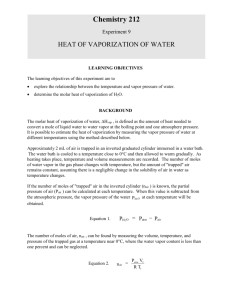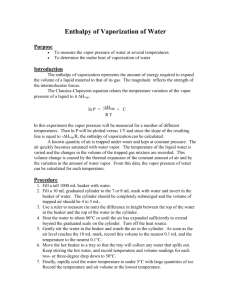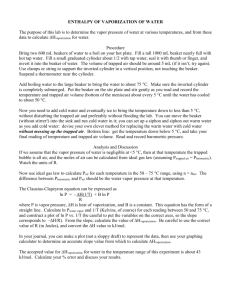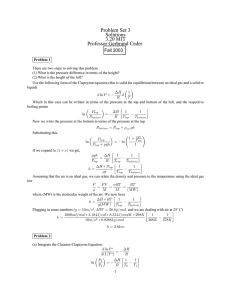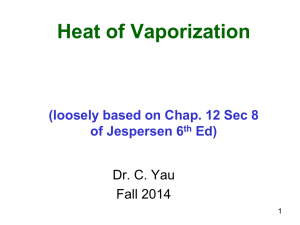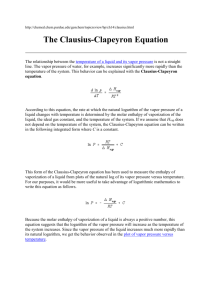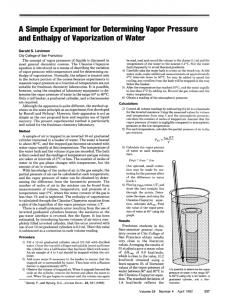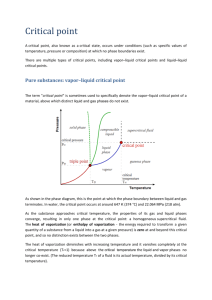VAPOR PRESSURE OF WATER
advertisement
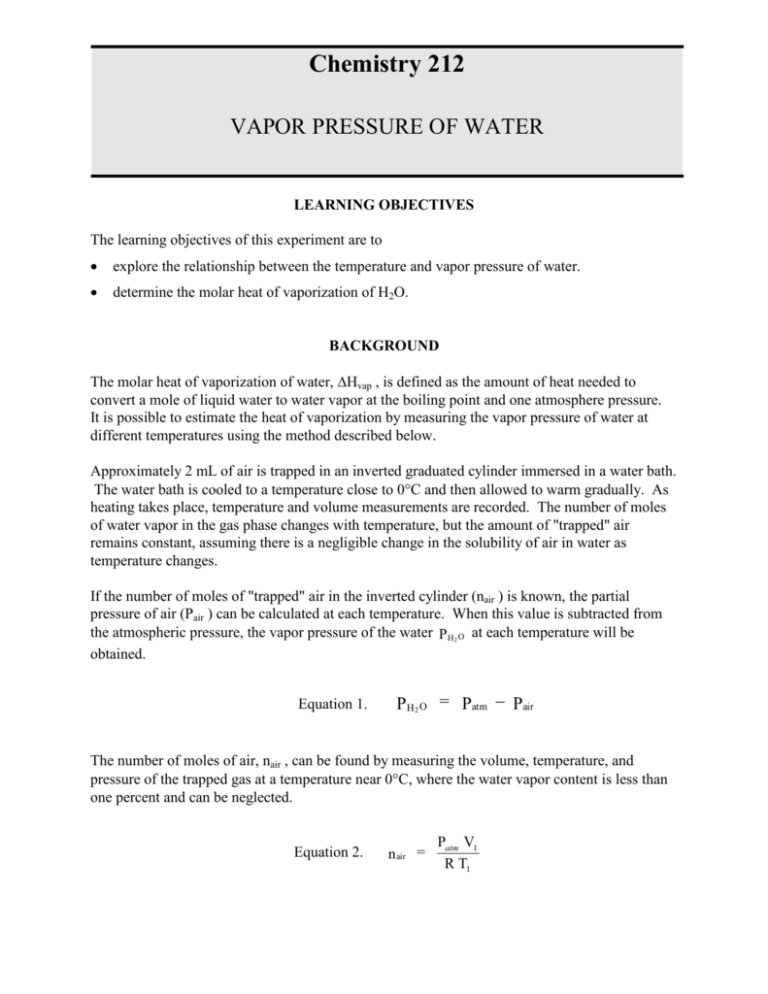
Chemistry 212 VAPOR PRESSURE OF WATER LEARNING OBJECTIVES The learning objectives of this experiment are to explore the relationship between the temperature and vapor pressure of water. determine the molar heat of vaporization of H2O. BACKGROUND The molar heat of vaporization of water, Hvap , is defined as the amount of heat needed to convert a mole of liquid water to water vapor at the boiling point and one atmosphere pressure. It is possible to estimate the heat of vaporization by measuring the vapor pressure of water at different temperatures using the method described below. Approximately 2 mL of air is trapped in an inverted graduated cylinder immersed in a water bath. The water bath is cooled to a temperature close to 0C and then allowed to warm gradually. As heating takes place, temperature and volume measurements are recorded. The number of moles of water vapor in the gas phase changes with temperature, but the amount of "trapped" air remains constant, assuming there is a negligible change in the solubility of air in water as temperature changes. If the number of moles of "trapped" air in the inverted cylinder (nair ) is known, the partial pressure of air (Pair ) can be calculated at each temperature. When this value is subtracted from the atmospheric pressure, the vapor pressure of the water P H2 O at each temperature will be obtained. Equation 1. PH 2 O = Patm Pair The number of moles of air, nair , can be found by measuring the volume, temperature, and pressure of the trapped gas at a temperature near 0C, where the water vapor content is less than one percent and can be neglected. Equation 2. n air = Patm V1 R T1 The molar heat of vaporization can be estimated by means of the Clapeyron equation. Equation 3. Hvap 1 ln PH 2O = C R T where and PH2O is the vapor pressure of water T is the absolute temperature R is the gas constant, 8.3145 J mol-1 K-1 C is a constant that depends on the particular liquid The vapor pressure is determined at a series of temperatures. ln (PH2O) is plotted against 1/T to give a straight line with a slope equal to -Hvap /R. SAFETY PRECAUTIONS Safety goggles must be worn at all times in the lab. EXPERIMENTAL PROCEDURE 1. Using two rubber bands fasten the temperature probe to the 10 mL graduated cylinder as shown in Figure 1. Leave about 1.5 cm between the tip of the thermometer and the opening of the tube. Make sure the rubber bands are not placed between the 1.6 and 7.0 mL markings so as to not obscure any volume readings. Temperature probe Figure 1. 2 2. Place about 300 mL of crushed ice in the large beaker and then fill it up with distilled water to about 500 mL. Stir the slush mixture until the temperature has dropped to approximately 0C and then remove any excess ice. Place the beaker on the hot plate but do not turn the heat on yet! 3. Fill the graduated tube with distilled water until it is about 2 cm from the top. Cover the top with your finger and invert to see if the air space is 2.2 mL. Adjust by adding or taking out some water until the space is about 2.2 mL. 4. Cover the top with your finger and invert the tube. Submerge the filled graduated cylinder in the large beaker filled with ice water and remove your finger. An air sample of about 2 mL should be trapped. Clamp the thermometer to the ring stand, making sure the tube is submerged and resting near the bottom of the beaker. Add more water to the beaker, if necessary, until the bath water level is more than 1 cm above the inverted tube. This is done to ensure that the trapped air in the tube is surrounded by water. 5. Turn on the stir bar and stir gently. Take a volume reading of the trapped air when the temperature is near 0C. If the temperature is not near 0C, add more ice to bring the temperature down. Make sure you are reading the bottom of the water meniscus. 6. Turn hot plate on and warm water gradually. Record temperature and air volume measurements often. Continue until temperature reaches approximately 80 oC. 7. Obtain the barometric pressure reading (Pa t m) and record. DATA ANALYSIS 1. Use Equation (2) to calculate the number of moles of "water less" air (nair). The temperature and volume readings needed are those obtained for the first data point (V1 and T1); R = 0.08206 L atm mol-1 K-1. Note: for each volume reading, one must subtract 0.15 mL to correct for the inverted meniscus. 2. In a Spreadsheet, calculate P H2 O , according to Equation (1). Note that Pair depends on temperature, and is determined by means of Equation (2). The formula used for this calculation, PH2O = Patm - Pair , must include the corrected volume in liters and temperature in Kelvin. 3. Plot a linear regression graph of ln ( P H2 O ) (column F) versus 1/T (column G) . 4. From the slope of your line determine Hvap for H2O. (slope = -Hvap/(8.314 J K-1 mol-1)) 3 5. Use the following literature values to calculate Hvap for H2O. These are from the CRC Handbook, 70th edition. Make sure to convert pressure to atmospheres. Temperature Celsius 0 5 10 15 20 25 30 35 40 45 50 55 60 65 70 75 80 PH2O mmHg 4.579 6.543 9.209 12.788 17.535 23.756 31.842 42.175 55.324 71.88 92.51 118.04 149.38 187.54 233.7 259.1 355.1 4 Data Sheet Data needed to calculate moles of “waterless air”: Barometric pressure reading (Patm) atm Lowest temperature reading (T1) K Initial volume at lowest temp (V1) L Moles of “water less” air (see Eq. 2) _______________moles Set up excel spreadsheet as follows: A Volume mL B C Temperature Temperature o C K D Corrected Volume L E PH2O F ln( PH2O) G 1/Temperature atm none K-1 In your results make sure to report the following: Hvap for water (literature value) _______________ Hvap for water (experimental value) _______________ Hvap for water (ave. class experimental value) _______________ 5 Chemistry 212 Pre Laboratory Questions VAPOR PRESSURE OF WATER Calculate the theoretical ∆Hvap for water from the given literature values. You will need to do this in excel, graph ln (PH2O (atm)) vs. 1/ (T (K)) . Look up the conversion factor for converting mmHg to atm. Attach the printed excel graph. 6
